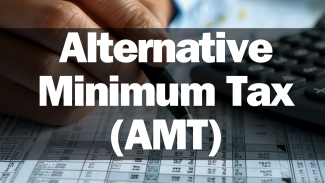
What is the Alternative Minimum Tax (AMT) and What You Need to Know in 2024
The Alternative Minimum Tax (AMT) is a separate tax system intended as a minimum floor to ensure that high-earners with extensive deductions pay a minimal amount of tax– either 26% or 28% on a calculated amount. Taxpayers with AMT exposure calculate their taxes twice: once under regular federal tax rules and then a second time under the stricter AMT rules, paying the higher amount of the two.
It’s particularly common for high-earners in tech to have AMT exposure because:
- You’re likely to have and exercise Incentive Stock Options (ISOs)— you can see a detailed example of how ISOs compare and contrast with RSUs here, given AMT exposure.
- You may have sizeable long-term capital gains from assets held over a year– such as tech stocks purchased at lower prices or cryptocurrency significantly appreciated in value.
- You may have lived and worked in high-state and local tax tech hubs in California and New York, and those state and local tax deductions are disallowed under the AMT.
The AMT isn’t a penalty or punishment for doing something wrong; it’s an unavoidable reality for high earners with multiple income streams. It’s the IRS’s way of capturing taxable revenue that could otherwise be substantially or entirely reduced with a litany of tax deductions. Many exemptions and deductions applicable under the regular tax system won’t typically apply under the AMT, including misc itemized deductions, large numbers of dependents, and significant medical expense deductions.
Still, there are ways to plan for and legally reduce your AMT exposure, and a tech-savvy financial planner can help chart your course for the best possible scenario. The following AMT guide goes over the AMT in high-level detail, how to calculate it, the most recent rates for 2023 and 2024, and a few tax planning strategies to mitigate high AMT exposure.
What is the Alternative Minimum Tax (AMT), and Why Does It Exist?
In 1966, 155 high-income (and very tax-sharp) people paid zero federal income tax through legal tax strategies. This revelation sparked a public outcry, and the IRS viewed it as a loss of face. Rather than eliminate the tax preferences and deductions that made it possible for taxpayers to reduce their taxable income, Congress created the AMT in 1969.
It’s often referred to as a safety net for the tax system. While it initially targeted the wealthiest taxpayers to close loopholes, over the years, it has affected a broader range of taxpayers, prompting criticisms and periodic adjustments to its parameters, the most recent being the Tax Cuts and Jobs Act of 2017. Today, it primarily affects high-earners and is most likely to impact those with annual incomes above $200,000. The exact threshold varies: AMT liability is influenced by the nature and amount of deductions and exemptions rather than just gross income.
These significant deductions include mortgage interest and high-state income and property tax deductions. The exercise of Incentive Stock Options (ISOs) to buy stock at a discounted price is considered taxable for AMT purposes but not for regular tax purposes. If the bargain element (the difference between the stock's current market value and the exercise price) is substantial, it could increase AMT exposure.
So, in theory, let’s say you just bought a home in San Francisco to accept a job at a startup where your equity compensation is in ISOs; you’d likely have some AMT exposure somewhere down the line– most likely when you meet your vesting criteria and choose to exercise your ISOs. Significant long-term capital gains can also trigger the AMT, particularly if you have a high ratio of long-term capital gains to ordinary income.
Think of a founder who sold her startup, which had appreciated significantly over the last five years. While long-term capital gains like this would be taxed at preferential rates of 15% to 20%, large amounts of income like this could cause a phase-out of the AMT exemption and indirectly cause it to apply to other income.
How is AMT Calculated?
Essentially, you calculate your taxes twice– once under the regular tax system and once under the AMT system. The AMT calculation disallows certain deductions you can take under the regular tax system, potentially increasing your taxable income. Ok, let’s take a brief pause here. It probably feels like a lot– you’re already going through the hassle of calculating your taxes once, but now you might have to do it again, but in a different way? Well, yes, potentially. Doing so correctly ensures you’re in good standing with the IRS, but also, with adequate preparation, you can do so strategically to save even more on your taxes. Most tax preparation software and CPAs will calculate your AMT for you automatically, so don’t worry about busting out the paper, pen, and calculator for now.
Here’s how your AMT is calculated:
Step #1: Calculate your regular taxable income. This is your initial figure before applying any AMT adjustments.
Step #2: Add back preferential deductions like property taxes and other advantageous tax breaks outlined in IRS Form 6251. These deductions are allowed under the regular tax system but not for AMT.
Step #3: Determine Your Alternative Minimum Taxable Income (AMTI) by adding these adjustments back to your taxable income.
Step #4: Subtract the AMT exemption from your AMTI, which is determined by your filing status and adjusts annually for inflation.
Step #5: Apply the AMT rates. Multiply the remaining income after exemption by the AMT tax rates (26% or 28%) to calculate your AMT. The rate depends on your AMTI.
If you’ve exercised any ISOs, calculate your AMT specifically for the ISOs by adding the bargain amount (the difference between the exercise price and the market value) to your income. This is done for AMT purposes but not for regular tax purposes. If you sell your ISOs within the same year that you exercise them, they do not count as AMT income but as ordinary income.
The AMT uses a two-bracket system– 26% and 28%– based on your income level after applying for AMT-specific adjustments and exemptions. 26% Rate: This rate applies to the initial portion of your Alternative Minimum Taxable Income (AMTI). For the 2023 tax year, if your AMTI is $206,100 or less (for married couples filing jointly; it's half that amount for single filers), the 26% rate applies. 28% Rate: If your AMTI exceeds $206,100 (for married filing jointly; again, half for single filers), this amount is taxed at 28%.
Step #6: Compare your AMT with your regular tax in step #1. If the AMT is higher, you owe the AMT amount. If it's lower, you pay the regular tax.
Step #7: Consider any AMT credits.
If you pay more under AMT due to deferral items like ISOs, you may be eligible for AMT credits, which can reduce your future tax liabilities. The credits are found on Form 8801. For example, you may get AMT credits back on the ISOs you exercised when you sold them. Remember that a tax credit is a dollar-for-dollar reduction in your tax bill, whereas a deduction just lowers your taxable income. For example, $10 in a tax credit will save you $10.00 in taxes, whereas $10 in tax deductions at a 30% marginal tax rate will save you about $3.00.
AMT in 2023 and 2024: What You Need to Know
The Tax Cuts and Jobs Act (TCJA) of 2017 reshaped the AMT landscape by raising exemptions, raising income levels for exemptions, and eliminating or reducing AMT’s preference and adjustment items. If that sounds like jibber-jabber, don’t worry. In plain speak, the TCJA made the AMT blow a bit lighter on some high-earners. The AMT is also indexed yearly for inflation. For the tax year 2023, individuals get an $81,300 exemption, and married couples get $126,500. If you're raking in $578,150 solo or $1,156,300 jointly in 2023, these exemptions start to fade.
The tax year 2024 is going up to $85,700 and $133,300, respectively. In 2024, the exemptions begin fading at $609,350 and $1,218,700 respectively. Are you saying that if I make more than the income threshold, I don't get any exemption at all? Yes, basically. The AMT exemption phase-out means that as your income increases above a certain threshold, the exemption amount you can subtract from your Alternative Minimum Taxable Income (AMTI) decreases. Once your income reaches a higher specified level, the exemption can be reduced to zero, meaning you don't get to subtract any exemption amount in your AMT calculations.
Final Thoughts and Tax Strategies for AMT
The Alternative Minimum Tax (AMT) is complicated to calculate and a bit off-putting if it’s your first exposure, but it’s a manageable consideration. A glass-half-full view considers AMT preferable to the ordinary federal rates—28% and 37% at each highest bracket. Still, tax planning goes a long way, especially with ISOs. A common strategy is to exercise ISOs up to the point where AMT kicks in, using tools like an AMT exercise calculator to estimate the optimal number of options to exercise without incurring the AMT– or even negotiating with your company for the length of time in which you can exercise or vesting schedule.
AMT planning could also involve your investment choices. For instance, investing in private activity bonds might increase AMT liability since interest from these bonds is subject to the AMT. Conversely, investing in AMT-free municipal bonds can provide income that's not subject to the AMT. Being aware of what triggers AMT and managing those triggers can help avoid unnecessary liability. For example, significant long-term capital gains can increase AMT exposure, so planning the timing of such gains can be crucial.
It’s critical to discuss how you can best plan whatever comes your way with a financial planner who knows the ins and outs of today’s tax code and how the tech industry’s best and brightest plan for their taxes, whether that be establishing a proper ISO holding period or utilizing AMT credits for future years.
